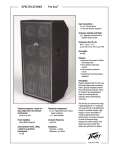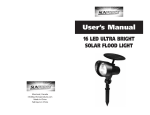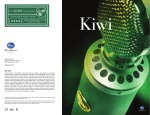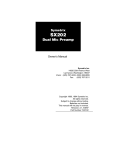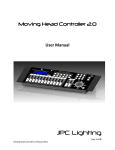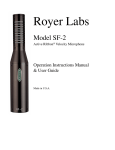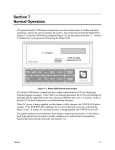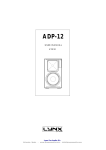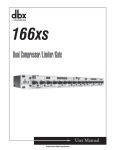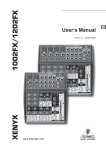Download R92 Owner`s Manual
Transcript
ribbonmics & preamps since 1964
www.ribbonmics.com | tel: +1-626-798-9128 | fax: +1-626-798-2378
ma
de in
c a l i fo r
nia
aea r92
CLASSIC PASSIVE RIBBON FOR UP-CLOSE
{ OWNER’S MANUAL }
{ WELCOME}
Congratulations on your purchase of the AEA R92 ribbon microphone
and welcome to the AEA family. Building on the success of the
acclaimed R84 ribbon microphone, AEA’s team of engineers set out
once again to expand the sonic possibilities of ribbon microphones
with the R92 model. Reduced proximity bass boost and excellent wind
blast protection make it suitable for close miking of guitar and bass
amps, drums and vocals. At half the distance to the source, the R92
delivers a similar bass-to-treble balance as the R84. In addition, the
integrated shock mount and swivel allow for easy setup and positioning
in tight spaces. Utilizing the R92’s option of contrasting ‘crisp’ front and
‘traditional’ back lobe make the microphone a great tool to implement in
the studio and live.
Your R92 microphone is 100% handcrafted in Pasadena, CA. AEA is a
family owned company with a small crew of skilled technicians – most
of them being musicians themselves. Proudly independent, we still
manufacture all our ribbon microphones and preamps by hand from
locally sourced parts.
Whether recording guitars, vocals, or kick drum, your R92 will impart
its classic Legacy series sound. We hope that the R92 will help you
capture many magical performances that touch the heart. Please read
this manual thoroughly to make sure that you get the best sound and
longevity from your new microphone. We invite you to become part of
the AEA community by sharing your experiences with the R92 via e-mail,
phone or our social media channels.
Wes Dooley
President of AEA
2
{ TABLE OF CONTENTS}
WELCOME2
INTRODUCTION4
GENERAL GUIDELINES4
APPLICATION ADVICE5
Dual Voicings 5
Controlling Leakage
6
Proximity Effect7
Preamps8
APPLICATION EXAMPLES8
Vocals9
Acoustic Guitar9
Electric Guitar9
Brass
& Woodwinds10
Drums & Percussion
10
PRECAUTIONS11
Phantom Power11
Wind Gusts11
Tramp Iron12
Microphone Positioning
12
Magnetic Stray Fields
13
SPECIFICATIONS14
WARRANTY16
SUPPORT16
{ INTRODUCTION}
The R92 is a pill-shaped, side-address, passive ribbon microphone with
a bidirectional (or figure-of-8) pickup pattern. It is assembled with the
same Big Ribbon™, tuning (16.5 Hz) and transformer as the R44. There
are several distinctions that make the R92 exceptional among AEA’s
Legacy line. The R92 was designed to accommodate close and medium
miking duties. It exhibits a flat frequency response when placed 6-12
inches (15-30 cm) away from the source, capturing the classic body
and dimension of the Big Ribbon™ sound with reduced bass proximity
effect. As a result, the mic is well suited for electric guitar, percussion,
brass, vocals and drums. Its compact, lightweight design and integrated
360º swivel mount allows for placement versatility, while the custom
shock mount suspension mitigates undesired low frequency mechanical
vibrations. What makes the R92 truly unique is the contrasting tonal
response on the front and back lobes: the front side is defined by a
“crisper” characteristic, while the back side has a smooth, “traditional”
top end roll-off.
{GENERAL GUIDELINES}
To maintain the best performance from your new AEA R92 microphone,
take note of these four basic rules:
1)
2)
3)
4)
Keep the microphone covered when it is not in use.
Always use a sturdy microphone stand.
Never expose the microphone to strong air turbulence.
Be nice to the microphone, and it will be nice to you.
1) Keeping the microphone covered when it is not in use will reduce the
possibility of damage that might result from a sudden gust of air coming
from air-conditioning or an open door or window. Place the supplied
protective bag (or a standard plastic bag) over the microphone when
it is not in use. For longer-term storage, place the microphone in its
protective case.
2) While the R92 was designed to work well with all standard
microphone stands, a high-quality boom stand will make your life a little
bit easier. Mounting the microphone on a strong, sturdy microphone
4
stand with a heavy base (or tripod) is essential. If you are using a boom,
make sure that it is properly balanced and that the tripod legs are
positioned appropriately to prevent tipping.
3) Ribbon microphones can withstand very high SPL (Sound Pressure
Level) without difficulty, but can be damaged easily by a sudden, strong
gust of air or high levels of very low frequency sound waves (like from
a kick drum or bass cabinet). This can stretch the ribbon, causing the
microphone to start sounding flabby. To avoid possible damage, follow
this simple procedure when positioning the microphone: put the back of
your hand where the mic will be; if you can feel the motion of air on your
hand, place a pop-filter between the microphone and the source of the
wind gusts. When recording kick drums or bass guitar cabinets, angle
the microphone to make sure that no wind blasts hit the ribbon head-on.
4) Your R92 is a valuable and important investment. Like any piece of
recording equipment or musical instrument, it requires common sense
and good basic care to keep it working properly. Given simple, basic
care as described above, your new microphone will perform admirably
for decades.
{APPLICATION ADVICE}
Dual Voicings - Endless Possibilities
AEA intentionally designed the R92 to capture slightly different frequency
responses on the front and rear pickup lobes. The front lobe of the R92
(denoted by the AEA emblem) is the “crisp” side, offering exceptionally
clean and realistic high end detail. The rear lobe is the traditional
“smooth” side, with the classic ribbon extended roll-off of the highs,
reminiscent of the iconic R44. This gentle roll off helps handle harsh
transients in a refined and flattering way.
The R92’s dual characteristic provides two significant options for your
recording or live projects. If one side isn’t doing the trick, try the other!
Figure-of-8 microphones are constructed with positive polarity on
the front and negative polarity on the back. When using the rear
lobe, remember to invert the polarity on your preamp or DAW. This
ensures your recordings with the back lobe will be in-phase with other
microphones.
5
s
l Axi
cipa
Prin
Nu
ll
Pla
n
e
Here is an illustration of the pickup pattern of the R92. The AEA logo
on the front of the R92 points directly towards the ‘principal axis’ (+)
indicated in the diagram.
Controlling Leakage
A significant and ever-present challenge in contemporary studio
recording is minimizing “bleed” (also called “leakage” or “crosstalk”)
from nearby instruments into the various microphones. The deep nulls
of bidirectional ribbon microphones provide good rejection of unwanted
sounds, which also can be beneficial in sound reinforcement situations
where feedback is always a threat. While gobos can be effective in
isolating performers from each other, they introduce their own set of
problems - not the least of which are reflections in close proximity to
the performers and/or microphones that result in comb-filter distortions.
Because gobos usually are bulky, they also inhibit the ability of the
musicians to hear and see each other easily. Such a setup requires
complex and often cumbersome headphone monitor mixes for the
musicians.
Because the R92 is bidirectional, it exhibit nulls at right angles to the
principal axis. These nulls produce a “plane of rejection” around the
sides, top and bottom of the mic that can be used effectively to reduce
leakage. Simply arrange the musicians so that nearby instruments are
placed in the “null” of their neighbor’s microphone, and vice versa.
Although this does not entirely eliminate the need for gobos, it can
significantly reduce their number.
Keep in mind that a certain degree of bleed doesn’t necessarily have
to be bad. For some styles and genres it can in fact be beneficial to
embrace a little bit of bleed in order to create cohesive and natural
6
sounding recordings. The important thing to listen for is whether or
not other instruments that bleed into a specific instrument microphone
still sound natural. You will generally find that well-designed ribbon
microphones like the R92 capture a natural off-axis sound, which means
that bleed from other instruments can contribute to the overall sound in a
pleasing way.
Proximity Effect
Proximity effect is a characteristic of all directional microphones; it
is a rise in low-frequency response that increases at closer working
distances. While this can be used to good effect, particularly with male
voices to give them an enhanced richness and depth, the potential trade
off is reduced articulation or clarity that can result from the masking
effect on the treble due to “excessive” bass boost.
The R92 and the AEA Nuvo N22 were both designed to shine on
close miking applications. However, as figure-of-8 microphones, they
intrinsically exhibit proximity effect. Compared to the R44, which
achieves proximity effect from six feet away, the proximity effect from the
R92 is substantially less and exhibits a flat frequency response when
placed at a distance of 6-12 inches (15-30 cm).
Experienced vocalists instinctively locate the proper working distances
for the microphones they are using. From as early as the 1930s,
Frank Sinatra always kept one hand on the microphone stand while
7
singing. Some joked that he simply was steadying himself, but more
knowledgeable people noticed that he would bring the mic closer
for more intimate moments, and then move it farther away when he
belted out a line. This technique became known as “working the mic.”
A simple technique for maintaining the proper working distance from
the microphone is to place a pop-screen between the performer and
the microphone. By doing this, performers, will naturally work at the
distance you have established.
Preamps
The R92’s passive system yields spectacular headroom and operates
with very low distortion over a huge dynamic and frequency range.
Without active electronics the R92 can handle 136dB SPL at 40
Hz and withstand 165+ dB SPL at 1 kHz and higher. Passive ribbon
microphones generally have low output level and require preamps that
supply a high level of gain. If the preamp you use doesn’t have enough
gain, the signal might seem too soft or noisy.
The preamp input impedance affects the output level of the mic in
addition to the mic’s frequency and transient response characteristics.
It is generally recommended to use a preamp that is at least 4 times
the input impedance of the microphone’s output impedance. However,
a low or very high input impedance on a preamp will not hurt a ribbon
microphone. We recommend clean, high impedance preamps with an
minimum input impedance of 1.2kΩ and at least 65dB of gain.
To unleash the full potential from your R92, AEA manufactures
high-quality, high-gain, low-noise preamps with a very high input
impedance designed to bring out the full frequency response of ribbon
microphones. Visit our preamplifier page (www.ribbonmics.com/
preamps) to view our line of exceptional preamps.
Application Examples
Your ears are obviously the best judge of microphone choice and
placement, but AEA has garnered a great deal of experience testing
the R92 in a variety of recording settings and by talking to experienced
musicians and engineers. As a result we suggest the following
guidelines to help you achieve optimal results when using the R92.
Watch the videos on our website (www.ribbonmics.com, www.
aeasessions.com) and on our YouTube channel
(www.youtube.com/AEAribbonmics) for more tips and tricks for our
microphones and preamps.
8
Vocals
Try using the R92 for a warm, clear vocal sound. The smooth character
of the R92’s treble response means that it may be extensively shaped
and processed without risk of nasty resonance artifacts.
Start by positioning the singer 4 to 6 inches (10-15 cm) directly on
axis from the microphone. The ribbon is well protected from damaging
plosive blasts, but to avoid noises from wind blasts, we recommend
using a pop filter.
If you are recording a musician who sings and plays an instrument at the
same time, you can make use of the exceptional rejection offered by the
90º “null” planes of the bidirectional pickup pattern to reduce the pickup
of the instrument in the vocal microphone.
Acoustic Guitar
When recording a solo acoustic guitar a good starting point is to
position the R92 4-8 inches (10-20 cm) away from the guitar roughly
pointing where the neck meets the body. This placement will capture
clear midrange and pick articulation with a balanced low end.
As the bass response of the R92 is sensitive to the miking distance, try
rotating the mic to use its excellent horizontal off-axis performance to
find the “sweet spot”. Try pulling the microphone away from the guitar
in increments of 1-2 inches (2-5 cm). Listen to the guitar up close and
when you find a spot that sounds good, try putting the R92 there. Let
your ears be your guide.
Electric Guitar
To capture an authentic and balanced guitar tone with your R92,
place the mic directly in front of the grill. Identify where the center of
the speaker cone is located, and place the R92 a few inches (5-10
cm) away from the speaker. Pointing the mic at the center of the cone
will deliver a very direct, “in-your-face” sound. This is the spot that
will obtain the most high-frequency content. If it sounds too harsh, try
moving the microphone slightly off center of the speaker cone. You
can also try positioning the R92 at an angle. You will find that small
differences in positioning can make huge differences in the sound,
so experiment until you find the spots you like. Close up, the R92 is
very good at spotlighting a speaker’s unique sounds at various cone
locations.
9
When using multiple microphones on a guitar cabinet at once and
mixing them to create a particular sound, it is important to pay attention
to the phase relationship between the different signals. Try to position
the different microphones as close to each other as possible, to avoid
phase problems caused by sound arriving at the microphones at slightly
different path lengths. Make sure to listen to the combined signal
summed to mono to catch potential comb filtering that could be caused
by out-of-phase signals. If you are recording with the back lobe of the
R92, it is important to invert the polarity on the preamp or DAW.
For a more natural sound that captures the sound of the amp in your
room, try moving the microphone back a couple of feet.
Brass & Woodwinds
The R92’s warm and detailed characteristics make it a great focus mic
for brass and woodwinds. Soprano saxophone, trumpet and most highpitched brass and woodwind instruments are known to have “edgier” or
“brilliant” frequency characteristics. The R92’s smooth treble response
on the back lobe is great at preserving these frequencies without
aggravating the striking tonal qualities.
Depending on the instrument’s dynamic range, we recommend starting
by positioning the R92 8-16 inches (20-41 cm) away from the source.
For a focused sound, use the swivel mount (not the mic stand) to point
the microphone on axis towards the bell or preferred tone holes.
If you are concerned about wind blasts, use a pop filter, or position the
microphone slightly off axis.
Drums & Percussion
The R92 excels at close and medium miking of drums and percussion.
A common use for the R92 is on kick drum. While it is never
recommended to put a ribbon mic inside or in front of the kick drum
port, positioning the mic a few inches away from the resonant head
angled slightly down can capture a very natural sound. Make sure that
you don’t feel an air blast on axis to the microphone.
Engineers also love this mic on toms. The R92 is great at capturing
huge low end and upper midrange. A common technique is to angle the
R92 so that it picks up the floor tom, but position it in a way that the
ride cymbal is in the null. It can produce a huge thud that is very natural.
10
{PRECAUTIONS}
Most ribbon microphones need little, if any, maintenance. Given proper
care they last for decades. Bing Crosby’s personal RCA-44BX (now in
the collection of the Pacific Pioneer Broadcasters in Hollywood) sounds
as good today as it did when he recorded his radio broadcasts in the
1940s.
A few simple precautions will help you to keep your AEA R92 working
well for life.
Phantom Power
Phantom power is not required or recommended for passive ribbon
mics. Passive ribbon or other any other microphones with transformercoupled outputs, from Shure SM57s to Neumann U47s, may be
damaged by phantom power. In most circumstances, accidentally
supplying phantom-power to your passive ribbon or other transformercoupled mics will NOT hurt the mic.
With a correctly wired cable and a properly working phantom power
supply, there is actually little danger of damaging the microphone with
phantom power. However, ribbons WILL get hurt if ground Pin 1 is
accidently shorted, or miswired to Pin 2 or 3. Using phantom power
with a faulty or miswired cable or a defective supply can severely
stretch or break a ribbon. Even if the ribbon survives, the microphone’s
output transformer core will now be magnetized and the sound of the
microphone will have changed. We recommend avoiding the use of
phantom power with your R92 as a general rule. It is recommended to
make a habit of disengaging phantom power a minute or two before
plugging your R92.
Wind Gusts
A second and equally important rule is never to blow directly into a
ribbon microphone to test it. Strong air movement can stretch the
ribbon and while it may not break, it nonetheless could significantly
degrade the microphone’s performance. The ribbon in the R92 is
protected by multi-layered screens and grill cloths to provide superior
wind protection. Nonetheless, using it outdoors requires special care to
avoid wind which can damage the ribbon.
11
Indoors, however, it is also important to avoid serious air movement
from stage curtains, open windows, doors, or air-conditioning systems.
High SPL sound sources do not usually pose a problem because AEA
ribbon microphones can handle 165 dB SPL or more without difficulty.
It is only those “explosive” sources that produce a strong blast of air,
such as the bass port on an electric guitar or bass amp, a guitar being
plugged (or unplugged) while the amp level is turned fully up, an onaxis kick-drum (particularly with a port on the front head), that are
potentially damaging. If you are unsure about how much wind is hitting
the microphone, place the back of your hand where the microphone is
going to be. If you can feel significant wind blasts, angle the microphone
or use a pop screen to avoid direct hits.
Tramp Iron
Minute iron particles, sometimes known as “tramp iron,” are common
within our environment. AEA ribbon microphones contain powerful
magnets that produce strong magnetic fields. These fields can attract
any ferric metal near the microphone that, if they are small enough, can
penetrate the outer screening and work their way inside the microphone.
Over time, this “tramp iron” can build up sufficiently in the magnetic gap
to rub against the ribbon causing distortion, electrical shorts or tearing
of the ribbon. The best prevention is to keep the microphone covered
with the supplied plastic bag when it is not in use.
Under no circumstances should you disassemble and take the grill off of
the microphone as this could allow tramp iron to enter the narrow gap
between the ribbon and the pole pieces. Disassembling the microphone
will VOID your warranty.
Microphone Positioning
The R92 was designed with placement versatility and vibration isolation
in mind. The microphone body is supported by a C-shaped yoke, and
is suspended using an elastic shock mount system. This structure was
designed to mitigate unwanted low frequency artifacts. To obtain the
shock mount benefits of the R92, we suggest adjusting the swivel
mount towards the source then positioning the angle of the mic stand.
The R92 includes a fixed XLR cable which is routed from the bottom of
the mic and secured to the right of the swivel on the yoke. Securing the
XLR cable to the stand is suggested to avoid accidents.
12
Magnetic Stray Fields
Ribbon microphones are fundamentally prone to picking up strong
external magnetic fields caused by light dimmers or nearby power
transformers. Guitar players will know this phenomenon from single-coil
pickups. Even though much attention was paid to suppressing such
sensitivity to external magnetic fields in the design of the R92, it is still
possible that you might encounter this problem. If you should pick up
a hum, try rotating or moving the microphone to find a spot where the
hum disappears, and try eliminating potential sources of stray magnetic
fields. You can use the microphone to find where hum is originating.
Rotate the mic for maximum interference and move it back and forth to
sense its direction.
The high-performance magnets used in the KU4 and R44 are incredibly
strong, and a significant amount of stray magnetic field lines surround
the microphone. Avoid placing the microphone in close proximity
to hard drives, credit cards, analog tape, or any other magnetically
sensitive items to prevent any data loss. These classic ribbon mics were
designed for maximum performance in professional environments with
well-trained technicians.
AEA’s legacy R92, R84, and R88 mics are designed to be less sensitive
to external interference. Their designs attract less “tramp iron” while
retaining the overall sound and 20 Hz bass response of the original
RCA 44.
13
{SPECIFICATIONS}
Operating Principle:
Directional Pattern:
Frequency Range:
Maximum SPL:
Sensitivity:
Output Impedance:
Recommended Load Impedance:
Phantom Power:
Polarity:
Pressure gradient transducer
Bidirectional
< 20 Hz to >20 kHz
165+ dB SPL (1% third harmonic > 1 kHz)
1.8 mV/Pa (-55 dBV) into unloaded circuit
270 Ω Broadband
1.2k Ω or greater
Not required or recommended
Pin 2 high for positive pressure at the
front of the microphone.
Polar Response:
Horizontal:
Native bidirectional, figure-of-8 pattern
Up to 90 dB rejection at right angles to the
front/back axis.
Level changes with angle of incidence, but
frequency response is consistent.
Vertical:
Transducer Element Material:
Thickness:
Width:
Length:
Pure aluminum corrugated ribbon
1.8 µm
0.185 in (4.7 mm)
2.35 in (59.7 mm)
Microphone Dimensions:
Height:
Width:
Depth:
Weight:
Shipping Weight:
Connector:
7.5 in (19.1 cm)
2.9 in (7.4 cm)
2.5 in (6.4 cm)
1.97 lb (893 g)
2 lbs (0.9 kg)
XLR-3M
14
Data below 200 Hz omitted due to measuring room restrictions.
0 dBr is equivalent to 1.8 mV/Pa at 1kHz.
Normalized to 0 dBr at 1kHz.
Accessories Included:
Storage/shipping case, plastic protection bag,
user manual, captive 10” (3 meter) output cable
with XLR-3M connector.
15
{WARRANTY}
Your R92 microphone comes with a one-year limited warranty on parts
and labor, shipping not included. Please see the supplied warranty card
for details.
Registering your microphone with AEA will extend the warranty to a full
three years. Simply fill out the supplied registration form and send it to:
Audio Engineering Associates
1029 N. Allen Ave
Pasadena, CA 91104
You may also register your AEA equipment online at
http://www.ribbonmics.com/aea/form.php
{SUPPORT}
If you should encounter any problems with your microphone or if you
have questions regarding using the R92 in specific application, please
contact our customer support team at [email protected]
To talk to a live human being, call +1 (626) 798-9128, between 8:00
a.m.- 6:00 p.m. PT Monday through Friday.
There are a number or audio and video recordings of various AEA
microphones online. Please visit www.ribbonmics.com
Manufactured by AEA Ribbon Mics & Preamps
1029 N. Allen Ave. Pasadena, California 91104, USA
Tel: +626-798-9128 Fax: +626-798-2378 www.ribbonmics.com





















